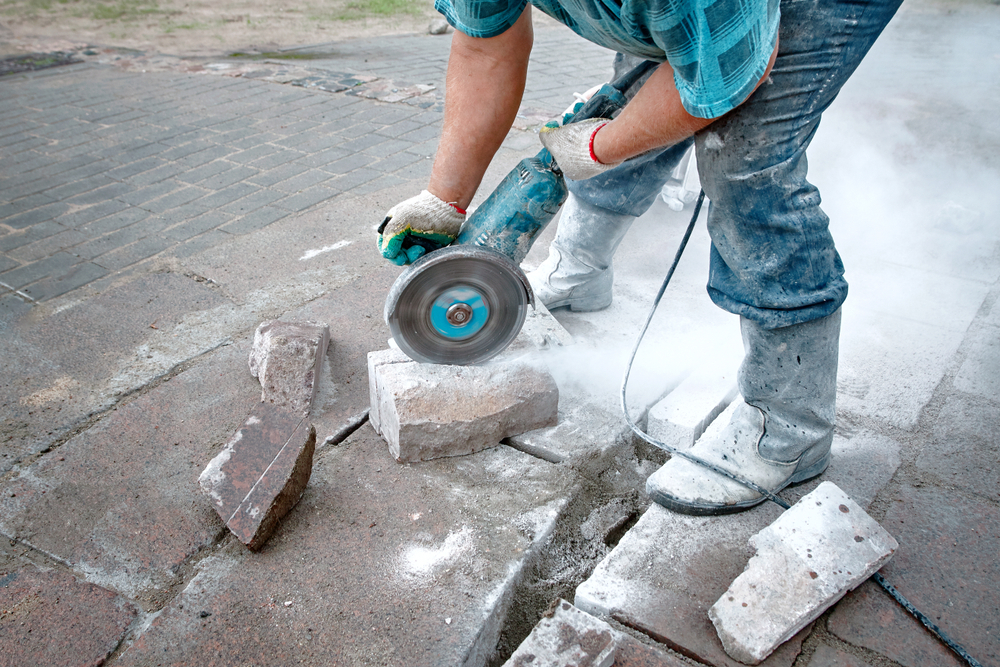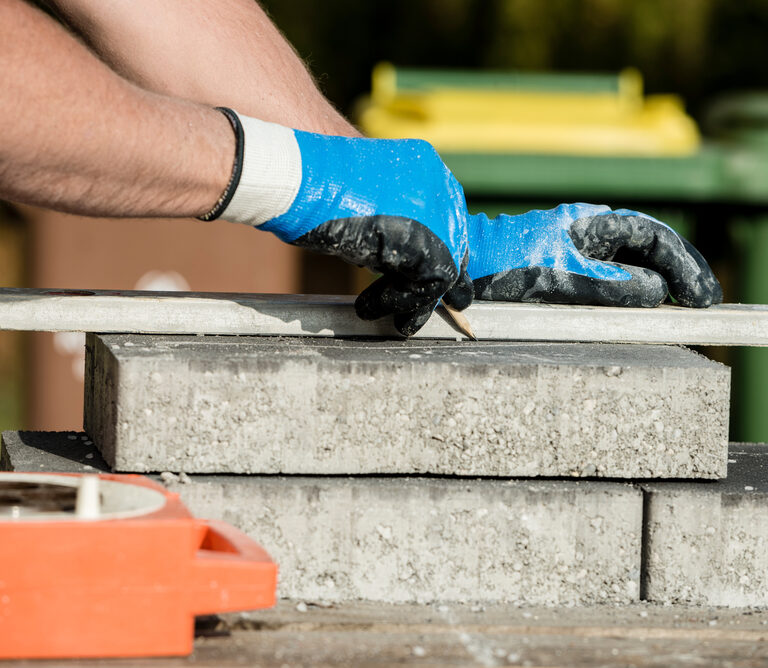You probably think you need to employ a professional in your quest to cut your concrete pavers, but you absolutely don’t. It’s a surprisingly easy, fuss-free job, and you can do it with very little equipment.
In this guide, we’ve brought you 3 easy ways to cut your own concrete pavers. We’ve included:
- Cutting concrete pavers with a hammer and chisel
- Cutting concrete pavers with a power saw
- Cutting concrete pavers with a paver splitter
We’ve also included a short video at the end of this article. It offers a brief, visual introduction to these three approaches, along with a couple of other ways you can get your paver cutting done.
Get your goggles on, stick your hands in your gloves and join us – here are three simple, easy ways to cut concrete pavers…
Cutting Concrete Pavers With a Hammer and Chisel
You’re probably surprised that you can cut a paving stone with a hammer and chisel.
But you absolutely can, and it’s an alarmingly easy job.
If you cut your concrete pavers with a hammer and chisel, you won’t get the same top-quality, reliable finish you’ll get with some of the other options we’ve featured in this guide. But, if you’re just cutting a few pavers, or if you don’t want to spend money on a pricier solution, this is a good option.
You’ll be left with relatively straight cuts, and it’s a great solution for any casual DIYers on a budget. Here’s how to do it:
1) Make a Mark
Take some chalk or other erasable writing material, and use it to mark a line across where you want to cut. Make sure you use a ruler or something similar to get a straight line. Without making a straight line (or any sort of line), you won’t make a straight cut.
2) Prep the Paver
Lie the paver somewhere flat. Don’t lie it on some other pavers, as the force of cutting it may damage the other pavers.
In this step, you want to prep the paver for cutting by scoring it with your hammer and chisel. For this stage (but only this stage), use a small, cold, steel, sharpened chisel.
You want to make a very small indentation along the entire paver (both sides and both edges). Be gentle as you do this – you’re only making small grooves, you’re not yet trying to cut it. If you’re too rough, you may accidentally cut some chips off the paver.
Because you’re being gentle, don’t be surprised if you have to do this step a couple of times to get a good groove.
3) Make the Cut
Now it’s time to cut.
You need to use a different chisel for this stage – use a brick-set chisel, which has a longer blade, and a much wider head for hitting it hard.
Hit your grooves hard and direct, and your concrete paver should easily come apart. If you’re struggling, try repeating step 2 again.
It’s important to be slow and patient – if you go too hard or too fast, you might end up splitting your concrete paver in an uneven (and unintended) way.
4) Remove the Rough Parts
If there are any rough edges or chunky bits sticking out, remove them with one of the two chisels you’ve already used. During this stage, make sure you’re nice and gentle again. You’ll never get your concrete pavers 100% flat by using a hammer and chisel, but you can get close with a little patience and persistence.
Cutting Concrete Pavers With a Power Saw

Next up, the entry you were expecting to see first.
If you have a lot of pavers that need cutting, or you want cleaner cuts, or you just have a power saw sitting at home, this is most likely the best option for you.
A word of warning on this one: using a power saw is obviously more dangerous than using a hammer and chisel, so be careful. Listen to your mom.
Any type of circular saw will do, whether it’s a masonry saw, an angle saw or whatever else. But whatever type of circular saw you’re using, here’s how to do it:
1) Choose the Right Blade
Before you actually start cutting into your pavers, make sure you have the correct type of blade. Broadly speaking, you want a diamond masonry blade.
A diamond masonry blade is best for any pavers, including concrete ones. That said, they’re often a little pricey, so if you don’t have lots of cash to hurl around, consider something cheaper instead.
If you’re planning to cut something other than concrete, buy a blade that’s suitable for that material. Stone, for example, is harder than concrete, and some blades which cut concrete won’t necessarily cut stone. No matter what you’re cutting, make sure you buy and use the right blade. If you’re in any doubt, go to your local hardware store for some advice.
2) Make Your Mark
Again, make sure you’ve marked your paver where you want to cut it. Use a ruler to make sure it’s nice and straight.
3) Get Cutting
It’s time to cut.
Before you do, though, make sure you’re keeping your paver firmly in place with some sort of non-slip pad. Or, if you prefer, fix it in place with a clamp. Unless you want to chop all your fingers off, you don’t want your paver slipping around.
When you get to cutting, you have two options:
- You can either cut through the entire thing…
- Or you can score the paver before hammering it into two pieces (just like you would with a hammer and chisel).
Of the two options above, do whatever you feel is safer, and whatever you have most confidence doing. Some people find the idea of scoring less scary than the idea of cutting the entire paver in half. Do whatever you’re comfortable with.
An Important Note
When cutting your concrete pavers with a mechanical saw, it’s possible to cut them if they’re wet or dry, but it’s much safer to cut them wet, as you won’t be breathing in loads of dust particles. Even if you’re wearing a good dust mask, you’ll still inhale some dust if you dry cut your pavers.
There’s more information on wet cutting and dry cutting later in this article.
Cutting Concrete Pavers With a Paver Splitter
Unless you’ve decided to embark on a brand-new career in paving, you probably won’t have (or won’t want to buy) a paver splitter. But if you do want to buy one, it’s (obviously) the best tool for the job. Paver splitters make the job ridiculously quick and easy.
Paver splitters are also the safest tool for the job. They don’t produce dust or loud noises, your fingers don’t go anywhere near any blades, and there’s not a giant circular saw whirring towards your hand.
In case you’re confused, a paver splitter is a guillotine-like machine specifically built for the job, and it’ll give you clean cuts every time. Here’s one in action.
How to Stay Safe When Cutting Concrete Pavers
When you’re cutting concrete pavers, you should always wear safety equipment and take safety precautions. Here’s what you need to consider:
Goggles and Gloves
Good safety goggles are essential, as you’ll get loads of lumps, dust and debris flying around.
You should also wear good gloves. This is especially important when using circular saws, but it’s important no matter how you’re cutting your pavers.
Dust Masks and Ear Defenders
If you’re using a power saw, you should absolutely wear a dust mask and ear defenders.
Circular saws can be ridiculously loud, while even a basic dust mask can massively reduce the chances of respiratory problems, illnesses and disorders. You don’t want to breathe in loads of dust.
Wet Cutting and Dry Cutting
Again, if you’re using a circular saw, you should cut your pavers wet rather than dry, even if you are wearing a dust mask. Wet cutting is better for you, and it can make your blades last longer.
For anyone who’s confused, here’s a helpful introduction to the basic differences between wet cutting and dry cutting.
Whether you’re cutting wet or dry, make sure the blade you’re using is suitable. Some blades aren’t suitable for both wet and dry cutting, so it’s important you’re using one that’ll get the job done properly and safely.
Final Thoughts
If you’re taking precautions, using the right equipment and following the step-by-step instructions above, all your paver cutting is gonna be safe, successful and stress-free. For a quick visual introduction to the three methods above (along with a few more), here’s a great video (Oh, but before you watch it, make sure you take better care of your fingers than this guy. I think he sort of wants to cut them off).
